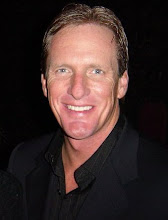Photo by Cincinnati Sports Photographer Vincent Rush
It wasn't the choicest of assignments for a sports photographer, covering the NFL draft. But there he was at the massive Jacob Javits Center in New York, and David Bergman had to come up with an idea.
"The first time I covered the draft I found a high angle to shoot from where you could see the green room, where the players were waiting with their families on one side, and the other players and the audience and all the excitement on the other sides. It ran as a two-page picture. Since then I've become SI's NFL draft photographer."
What's that about no good deed going unpunished?
"I feel like I have to get something new and different and unique every time," David said. "I take it upon myself to go the extra mile and make things just a little different."
David has worked hard to build a reputation as the guy who will come up with a shot that nobody else thought of.
"It's a big risk because you have to put yourself out there and maybe leave the safe position to get something different. Sometimes it doesn't work. But it's worth the risk because when you get the shot, it's a great feeling."
Case in point. David had been sent to University Park, Pa., by Sports Illustrated to cover a big game between Penn State and Notre Dame. David, the lone SI photographer, took plenty of action shots in the first quarter, then began to look around. What was different about this game?
"On a normal big game at Penn State, they do what they call a White Out. Normally it's just the student section—a big swath in the stadium that's all white."
But at this game, Bergman noticed, everyone was wearing white. "They called it the White House," he said.
"I realized that this could make an interesting picture. I left the field in the second quarter and went to the top of the stadium. I missed a lot of the game, but I was able to shoot the entire stadium, with everyone wearing white, just as the sun was setting."
It ran as a two-page spread in the next issue of Sports Illustrated. "I still get an email once every month from some Penn State fan somewhere in the country or in the world, wanting a copy of the picture." That's what Bergman likes to do and why he's in high demand.
"I like to show the scene. I like to show the setting. I like to give the viewer a feeling of place. It's not just a tight picture of the running back coming straight at me. It's the running back coming at me, and you can see the snow falling, and the stadium, and you get a sense of place."
Whether he's shooting the Nittany Lions at Penn State's Beaver Stadium, Avril Lavigne playing to a packed arena or an intimate portrait of, say, bassist Pete Wentz of Fall Out Boy. Bergman's tool of choice is the Nikon D3. "It's my workhorse camera," he said. "It's built like a tank, and it's fast. I've shot in every kind of weather condition, from blizzards to monsoons."
Originally a music major, Bergman moves easily from the sports arena to the rock stage, shooting everyone from Ozzy Osbourne and Barenaked Ladies to Gloria Estefan and Seal. He shoots editorially for publications such as the British heavy-metal magazine Kerrang!, as well as commercially for the artists.
"Sports and music are alike in a lot of ways," Bergman said. "Specifically, concert photography and sporting events are very alike. There's an element of unpredictability. You have to deal with changing lighting. There's a limited space where things are going to happen, and you have no idea what's going to happen.
"The portraits, though, are a very different thing.
"I used to travel with four or five heavy cases of equipment just to do a single portrait. You'd have to bring an entire photo studio on the road." That was before Bergman discovered the compact, portable Nikon Speedlight system.
"That has really changed my life," he said. "I can get on the airplane with one rolling bag and one small sling bag with light stands, and I have an entire studio with me on the plane. I can travel with six Speedlights and do just about anything I could do with those four big heavy cases I used to travel with."
One thing about using lights that are so small is I can put them anywhere. I can put them under a couch. I can put them up on a ledge. I can hook them to a bookshelf. I can stick these lights just about anywhere. With studio light you just can't do that."
Bergman shot four World Series games, again turning to the Nikon D700 "and my favorite Nikon lens, which is the NIKKOR 200-400mm zoom."
Each of the resulting images, shot from centerfield, actually comprises 675 individual photos shot over 53 minutes.
"When you stitch these together into one giant photo it's ridiculous," he said. "It would be nearly 30 feet wide at 300 pixels per inch."
He almost makes it sound easy. Bergman knows, however, that a good picture is hard work, whether you're shooting a stadium filled with baseball fans or just the family.
"When I pull out the camera it's because I want to make a picture," he said. "I'll go through the extra effort because I want to make pictures that people remember."
See more of David's work visit his website. http://www.davidbergman.net/




.jpg)